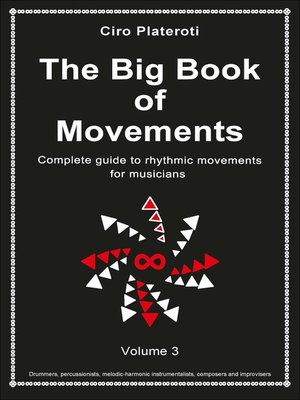
Sign up to save your library
With an OverDrive account, you can save your favorite libraries for at-a-glance information about availability. Find out more about OverDrive accounts.
Find this title in Libby, the library reading app by OverDrive.



Search for a digital library with this title
Title found at these libraries:
| Library Name | Distance |
|---|---|
| Loading... |
The Great Book of Movements is a musical method to develop rhythmic sense through the physical coordination of both hands or feet.
It is divided into three volumes. Although it is ideal for drummers and percussionists of any style or instrument, it is aimed at musicians in general, whether they are singers, pianists, bassists, guitarists, Hang Drum players or similar, electronic music artists or, for those who wish to maximize their potential musical strengthening their rhythmic and emotional senses ..
Throughout the three volumes all possible combinations of movement patterns for hands or feet are discussed.
They are grouped in diagrams of different amounts of figures (2, 3, 4, 5, 6, 7, 8, 9, 10, 11, 12, 13, 14, 15 and 16) this organization allows us to exercise an infinity of rhythmic patterns playing with a large number of metrics, ternary and irregular binaries.
In this volume (3) diagrams of 16 movement patterns per measure are included in Volume (1) of 2 and 13, finally in Volume (2) diagrams of 14 to 15 patterns.
Instrumentalists, improvisers and composers, both rhythmic, melodic or harmonic, have in this method a large number of resources that facilitate the incorporation and articulation of thousands of rhythmic patterns that, when exercised, generate their own language of movement and directly revitalize the flow creative. Rhythm is one of the vital and structural forces in existence, it is the driving spirit of the movements that give order to the events of nature. Taken this concept to the musical plane, the rhythm itself through repetition, gives direction, fluidity and above all, form and structure Each musical phrase is a physical (or ethereal) object with defined contours and shapes, and precisely the exact limits of those outlines and shapes are created primarily by rhythmic movement. Take the example of a chord or a melody, without rhythm, they are amorphous, they have no duration or pauses, they lack powerful energy, they lack definite shapes. As musicians we can know about scales, arpeggios, harmony, reading, etc. But for these elements to acquire a vital and dynamic meaning, expressing it metaphorically, we must apply the breath of a god in a doll (made of clay) so that it transforms into a being of flesh and blood with a soul, we must give shape and life to our music through rhythmic movement. By incorporating these concepts, based on expanding the soul and rhythmic awareness, we will have acquired a great tool to enhance our creativity and the more concrete and rich our music will be.







